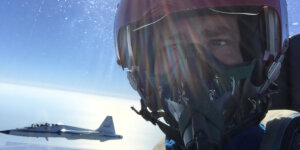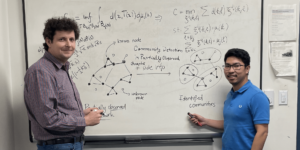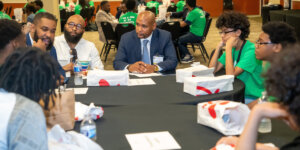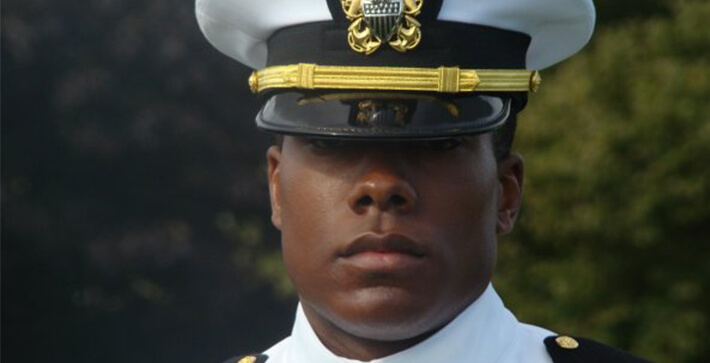
USC Viterbi graduate student David Long in his Navy officer’s uniform. Photo courtesy of David Long
Joseph Campbell who wrote the famous book “The Hero With a Thousand Faces” that George Lucas leaned on for writing Star Wars, defined a hero as “someone who has given his or her life to something bigger than oneself.”
David Long did just that when he joined the Navy. After rigorous training, Long became a radar and weapons console operator and later a nuclear reactor operator for the USS George Washington, nicknamed by sailors ‘The Spirit of Freedom’.
We connected virtually with Long, who now lives in Chesapeake, Virginia as a fulltime Trojan pursuing a Master of Science in Engineering Management (MSEMT) in the DEN@Viterbi program. He gave us a glimpse of his experiences aboard one of America’s most storied ships as he sailed from the Navy into the world of USC engineering.
What sort of training did you have to go through to operate radar and weapon consoles? That’s a pretty hefty power to have at your fingertips, it must be more than just technical know-how.
From the time you step on board you are immersed in training to learn all of the systems on the ship. This ranges from engineering systems, damage control systems, and weapons systems. You are given a rather large qualification book that states all requirements to learn and be certified on that system. Some of the requirements are just “observes” or “simulates” but most have to actually be performed by you as the watch stander.
For example, we wouldn’t actually launch a SM-II missile for someone to qualify that would of course be a simulation. There are three major phases of the qualification process for Naval Officers. They include Surface Warfare Officer Engineering (the engineering plant systems for ship’s propulsion), Combat information center watch officer (radar and weapons systems), and Officer of the Deck (maneuvering and handling the ship to get it from point A to point B and on station for different mission requirements). Each phase involves a line item requirement as well as an oral board team. After all three phases are completed you go up for surface warfare officer qualification, which is a culmination of everything you’ve learned in the previous 18 to 24 months. This is done with the Captain of the ship who finally qualifies you as a Surface Warfare Officer.
What was it like to be on USS George Washington with such a great responsibility within reach?
It’s an awesome experience! I remember when I first qualified Officer of the Deck and I was on my first night watch at only 23 years old. Just about everyone else was asleep, except me and my watch team. We were responsible for navigating and maneuvering the ship to a rendezvous point to do an underway replenishment for more supplies and fuel. You’re given a great responsibility at a very young age but the training you receive prepares you for it. There are brand new sailors on the ship but also senior officers and chiefs who’ve been in the service for over 20 years. The amount of knowledge on board is a great asset open to everyone. If you don’t know, you ask.
What was life like on the ship? Walk us through a daily routine?
After I received my surface warfare officer qualification, I went on to nuclear power school and prototype training to be able to on-board an aircraft carrier and operate the 2 nuclear reactors on board. The steam produced by the reactors provides power for the ship’s propulsion, electricity generation, potable water production, and catapult capability for the fighter jets. We stand watch in the engineering plant in time blocks of 7am-12pm, 12pm-5pm, 5pm-10pm, 10pm-2am, and 2am-7am. We stand watch in three sections which means you stand a watch block and are off the next 2 blocks. For example, I would stand the 7-12, be off the 12-5 and 5-10 then go back on watch for 10pm-2am be off the 2-7 and 7-12 then go back on 12pm-5pm and rotation continues. On watch I was responsible for maintaining the safe operation of the nuclear plant in addition to any maintenance and evolutions such as flight operations that required specific lineups of the engineering plant to be in place to support those operations.
In addition, you have to handle the rest the daily “normal” work throughout the day. Everyday there is administration, training, and meetings for upcoming evolutions. And, if something breaks, it gets thrown into the mix.
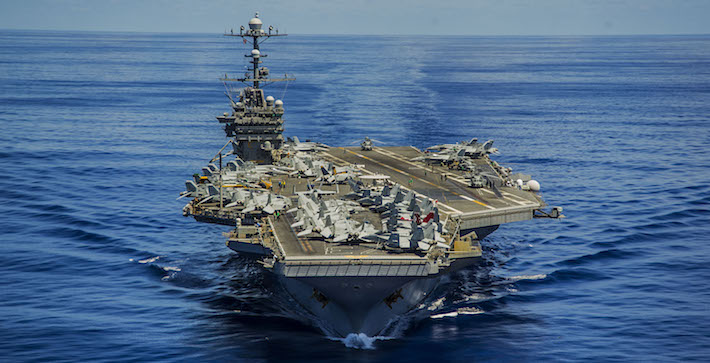
USS George Washington Photo / U.S. Navy
What led you to join the Navy?
I joined because of the sense of giving back. Think about it, the reason you cookout in your backyard on the weekend or go to an amusement park with your family without any real fear of bombs from a foreign country landing on you is because of the great presence that the U.S. military has. I wanted to be a part of that.
In high school I really started paying attention to what was happening around the world. I decided I was going to join right out of high school but my mother convinced me to go to college first and get my degree which proved to be a great choice because it made it possible for me to go in as an officer.
How was your transition between working in the navy and coming to USC and what has been your favorite part about USC so far?
I left the Navy in December of 2014. I studied for the GRE during that spring of 2015 and applied to schools. I was accepted by USC and began the MSEMT program in fall of 2015. My favorite part of USC has been the ease of being a DEN student. I have the flexibility to attend class virtually from Japan but also participate like an on-campus student.
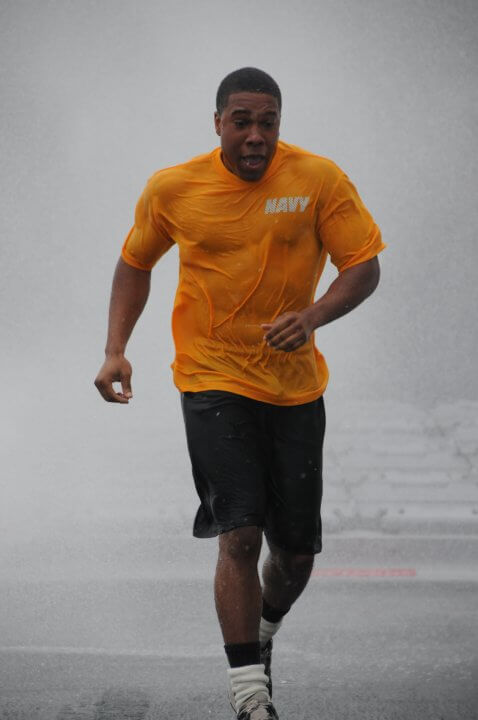
Navy officer and USC Viterbi masters student David Long in training Photo courtesy of David Long
What made you choose a career in engineering?
Growing up, I was always interested in working with my hands, especially working on cars. I felt engineering, specifically mechanical or civil engineering, would be a good match for me. I ended up studying mechanical engineering at Georgia Tech. That certainly helped prepare me for the nuclear training in the Navy. After leaving the Navy, I didn’t want to narrow my options by going for a Masters in mechanical engineering, so I chose engineering management to broaden my technical and financial leadership.
Do you still keep tabs of what is happening aboard the USS George Washington?
My wife is still active duty in the Navy and a couple of years younger than me. She is also a nuclear trained officer. Surprisingly, she got orders to my same ship – the USS George Washington! Her ship has since changed homeports from Japan to Norfolk, Virginia. That is where we live now. It’s a very cool connection that we share. Some of the sailors who I used to work with are still on board and remember me so they look out for her.
Published on November 9th, 2016
Last updated on March 10th, 2017




